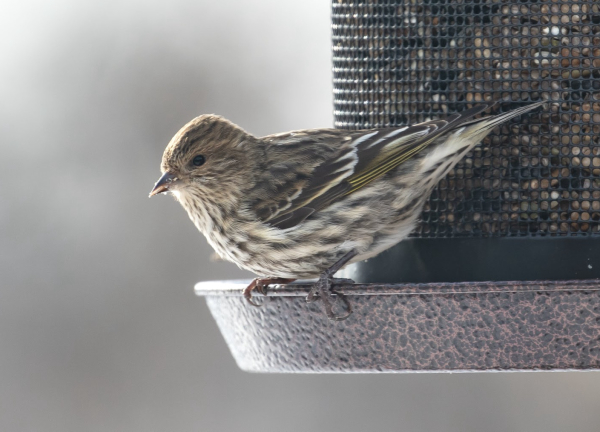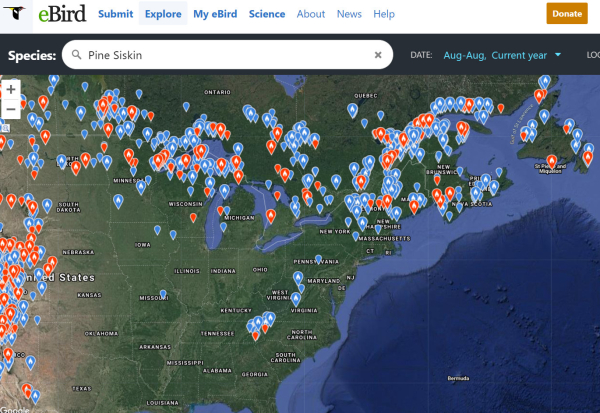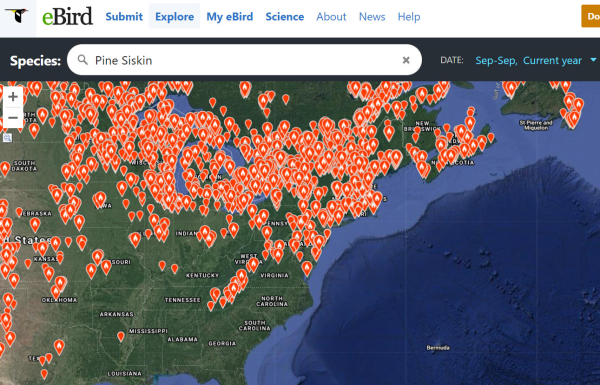
Pine Siskins are the first northern finches to “invade” southward this fall in advance of what should be a good finch winter at many backyard feeding stations.

You can compare Pine Siskin eBird report maps in the Northeast during August (above) and September (below) that demonstrate the recent southward movements of these northern finches.

|
Pine Siskins have already started to move southward across the United States as they are now being reported feeding on pine cone seeds and at bird feeders across the West, Midwest, New England, and even into the southern states of Louisiana, Texas, and coastal North Carolina. Low pine cone production in the boreal forest – the northern pine and spruce forests that stretch from Alaska across Canada and into the northern Great Lakes and New England – has forced Pine Siskins south in big numbers during the past 10 days. Can northern grosbeaks and crossbills be far behind?
Pine Siskins have already started to move southward across the United States as they are now being reported feeding on pine cone seeds and at bird feeders across the West, Midwest, New England, and even into the southern states of Louisiana, Texas, and coastal North Carolina. Low pine cone production in the boreal forest – the northern pine and spruce forests that stretch from Alaska across Canada and into the northern Great Lakes and New England – has forced Pine Siskins south in big numbers during the past 10 days. Can northern grosbeaks and crossbills be far behind?
Pine Siskins are the ultimate generalist finches in boreal forest and mountain pine habitats where they feed on conifer seeds, deciduous tree seeds from alders and birches, as well as grass and thistle seeds. Although some Pine Siskins regularly migrate south during fall, many more will also “irrupt” southward or eastward approximately every second year in response to poor conifer seed crops in the core of their boreal forest range. However, Pine Siskin movements are erratic, and these birds might appear at unexpected times and in unexpected places.
Recent predictions by the Finch Network indicated that many Pine Siskins would remain in western Canada due to strong spruce seed production, but those in the eastern forests would likely move southward in search of conifer cone seeds and feeder fare. However, the present movement of Pine Siskins has already exceeded expectations, both in the East and the West. For example, a massive movement of Pine Siskins was reported last week (Tuesday, September 29) on Vancouver Island, British Columbia – northwest of Seattle. One eBird report estimated more than 3,000 Pine Siskins flying southeast in “continuous flocks.”
Finch Foods
Pine Finches use their pointed bill to eat small seeds, and they prefer nyjer (thistle) seeds in feeders – hopper feeders are best, but you can also mix thistle seeds with sunflower seeds and your regular fair at platform feeders. It’s also best to use a good nyjer thistle seed feeder that won’t be hijacked or dominated by squirrels. Although they aren’t the most colorful finches, they are great fun to watch, and everyone agrees they are among the most welcome winter visitors to any feeding station.
Of course, American Goldfinches and the full variety of goldfinches all feed on nyjer thistle seeds too, so if you are already attracting goldfinches, you’re on the right track, and can expect Pine Siskins and Purple Finches to share the feeder if they move into your area.
Some of the larger finches – including Evening Grosbeaks, Pine Grosbeaks, Red Crossbills, White-winged Crossbills, and other northern finches – prefer larger seeds, especially black oil sunflower seeds and other sunflower seed types. It might be best to offer a good mix of seeds to ensure a new species finds something it likes and will return to your feeding station.
By providing these basic feeder seeds, you may attract members of these colorful finch species, but you will also attract other birds that prefer these seed types, including Red-breasted Nuthatches, along with your regular nuthatch species visitors, a variety of woodpeckers, chickadees, titmice, and other attractive birds. As fall progresses, more and more birds will become regular feeder visitors, and hopefully northern finches will be among the mix this year.
Share Your Sightings
If you’re lucky enough to encounter Pine Siskins and other northern finch species listed above at your feeder or during birding hikes, you are asked to please fill out a report on eBird at https://ebird.org/home to help provide information for the Finch Research Network and other groups that monitor winter bird numbers and movements.
The Finch Research Network is committed to researching and protecting finch species and related birds. You can review the original article that provided information for this article, along with interviews, other articles, and historical data at https://finchnetwork.org/irruption-alert-pine-siskin
Share your backyard birding experiences and photos at editorstbw2@gmail.com